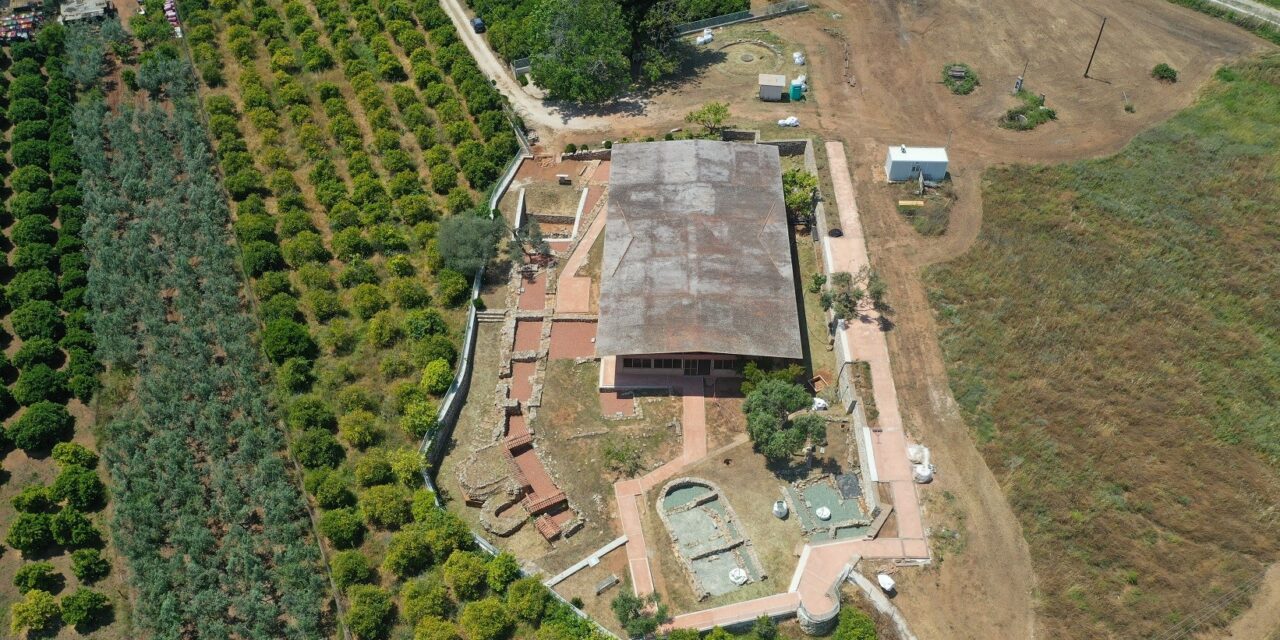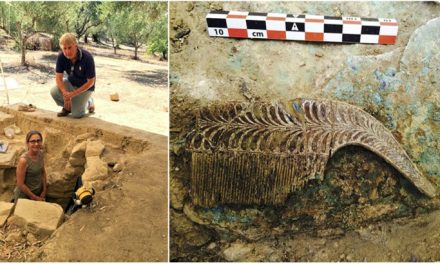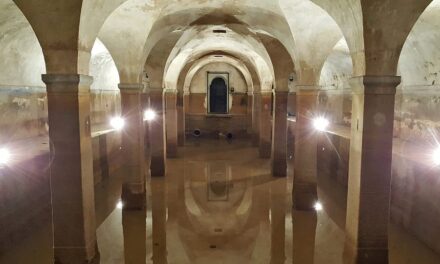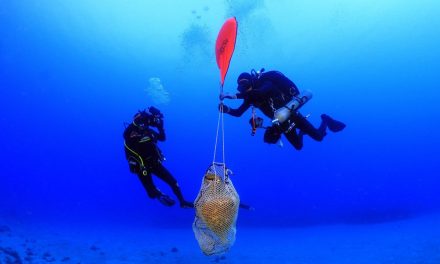Lerna, located on the west side of the Argolic Gulf in the eastern Peloponnese near the modern village of Myloi, is one of the most important prehistoric sites in the Greek world. The settlement extended over a low hill, only 5.50m in height and covering a total area of 180m by 160m. This hill was formed through the accumulation of successive layers of habitation over approximately 5,500 years, from the Neolithic to the Mycenaean period (mid-7th to 1st millennium BC). The choice of this location as a place for a permanent settlement was due to its abundant natural resources, including fertile land, and the springs of Lerna. Additionally, its proximity to the sea and the mountains of Arcadia ensured its residents control of maritime trade routes as well as the possibility of controlling the passage to Arcadia.

General view of Lerna (Source: American School of Classical Studies at Athens, ASCSA)
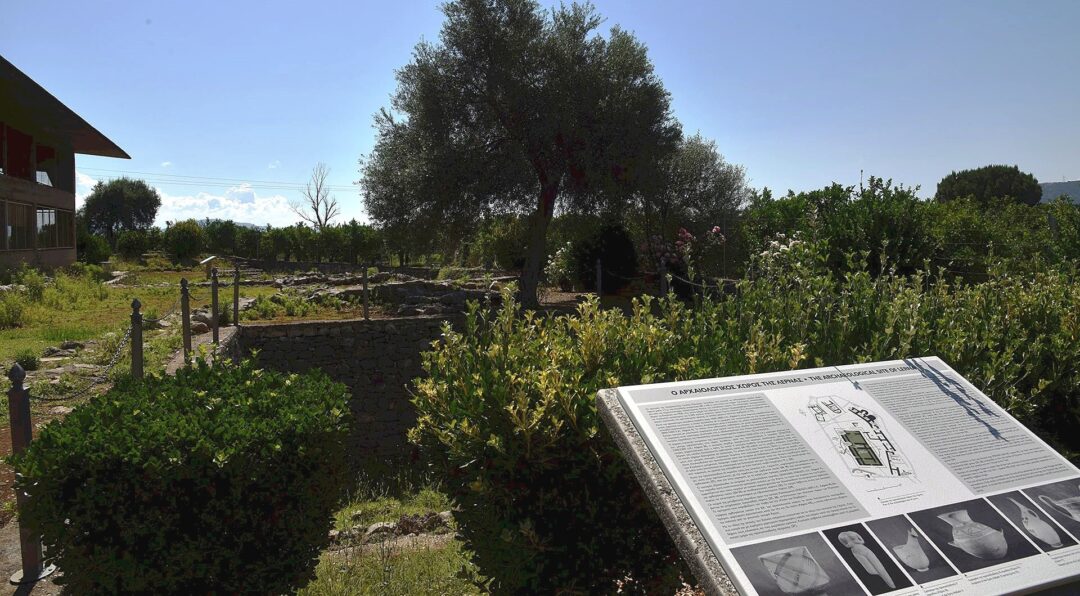
Lerna, the archaeological site (Source: Ephorate of Antiquities of Argolida)
Systematic excavations were conducted from 1952 until 1958 by the American School of Classical Studies at Athens (ASCSA) under the direction of Professor J.L. Caskey. These were confined to the southern section of the tumulus and brought to light seven main chronological phases of human occupation identified by the Roman numerals I-VII.
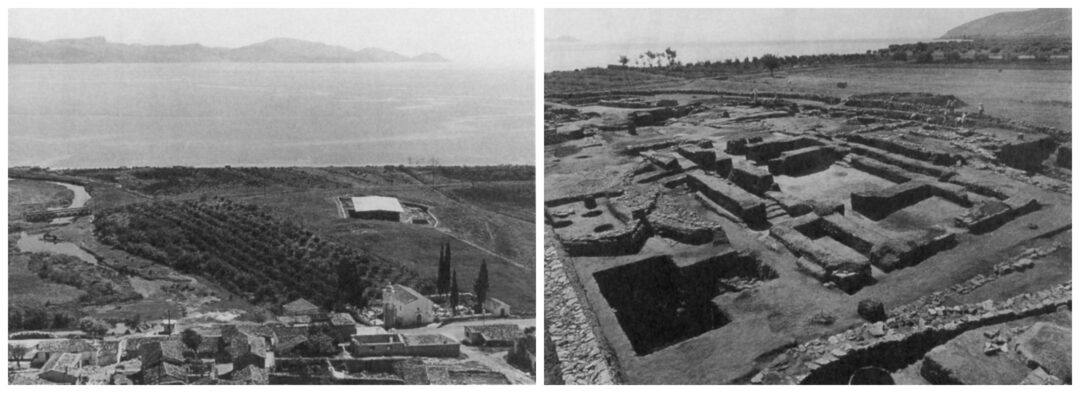
General view of Lerna (Source: American School of Classical Studies at Athens, ASCSA)
Excavations in the deeper levels have uncovered houses from the Early and Middle Neolithic periods (Lerna I and II: 6th-5th millennium BC), with a Middle Neolithic house still visible today. Lerna reached its peak during the Early Helladic II phase (Lerna III: 2700-2200 BC), at which the settlement acquired a strong wall with a gate and two towers on the south side. Among the rectangular houses of this period a monumental building stands out, 12m x 25m in size, with the main entrance on the east and a row of rooms running East-West and corridors on its long sides. It was a two-storey construction built with stone foundations and a superstructure of unbaked brick, and it had a tile roof. Many of them were found in the destruction level and gave the buildings its name ‘House of Tiles’ (today preserved under a large, modern shelter). In the southernmost of the two small rooms that could be accessed only from the outside of the building were found more than 150 clay sealings bearing the impressions of some 60 seals.
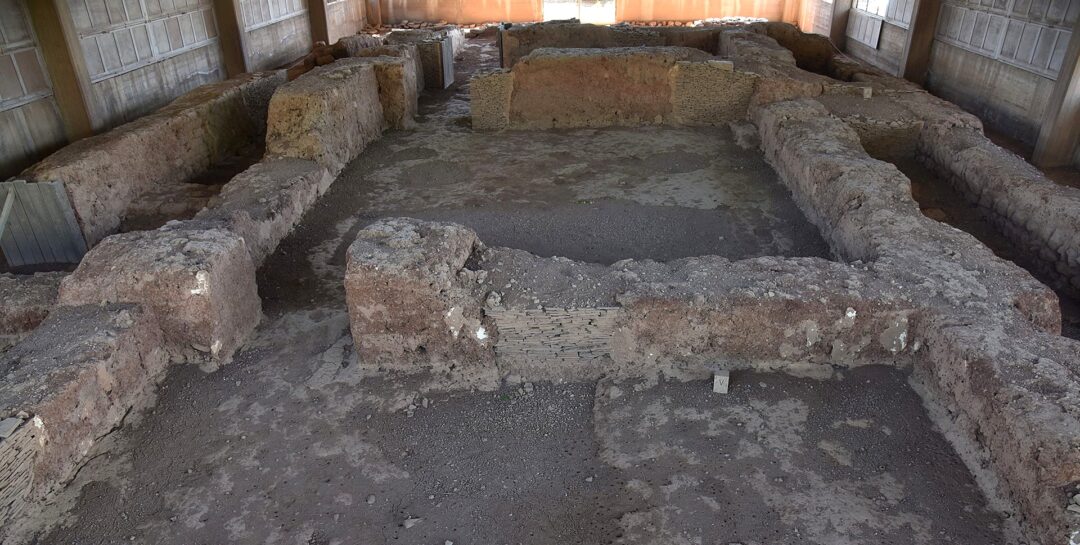
Lerna, The House of Tiles, (Source: Ephorate of Antiquities of Argolida)
The “House of the Tiles” was destroyed by fire before its completion. Its complex architecture, the sealings, and the fact that after its destruction residents revered it by constructing above it a circular tumulus that marked the site testify to its having been the commercial and administrative center of the entire surrounding region and suggest the presence of an early urban system with centralized administration. Its destruction was probably owed to the arrival of new inhabitants who later built new houses above the tumulus (Early Helladic III period: late 3rd millennium: Lerna IV) and introduced new practices in architecture (apsidal houses) and in pottery (use of an early form of potter’s wheel).
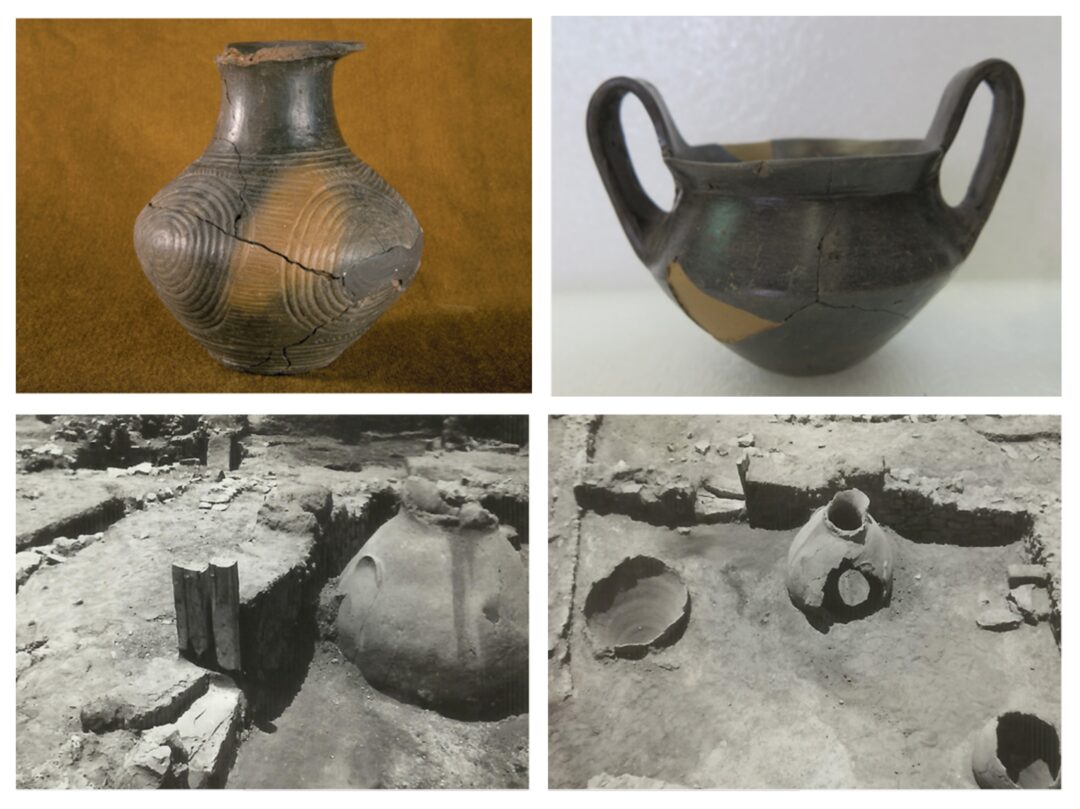
Lerna, The Middle Helladic complex with a food storage area. Kantharos from Room 45 (top left), Imported vessel (flask) from Room 44 (top right), Room 45: The doorway with the wooden jamb partially restored (lower left), Room 45 (food storage area with pithoi) (lower right) [Source: American School of Classical Studies at Athens, Lerna Excavations Archive].
Habitation continued during the Middle Helladic period (Lerna V: 2000 – 1700 BC). During this period the settlement flourished as agricultural production became more systematic and commercial relations developed with Aegina, the Aegean islands, and Crete. At the time of the transition to the Late Helladic period (Lerna VI: 1700-1600 BC) two shaft graves were dug into the ruins of the House of Tiles. During the Mycenaean period (14th-13th c. BC: Lerna VII) the settlement continued to be inhabited, though in the shadow of Mycenae and Tiryns.The mound was used mainly as a cemetery and only sporadically for habitation. The end of the Lerna settlement essentially came with the end of the Bronze Age. In about 1250 BC, the site was definitely abandoned.
(Source: Ephorate of Antiquities of Argolida, Hellenic Organization of Cultural Resources Development-HOCRED)
The finds from the Lerna excavations are exhibited in the Archaeological Museum of Argos.
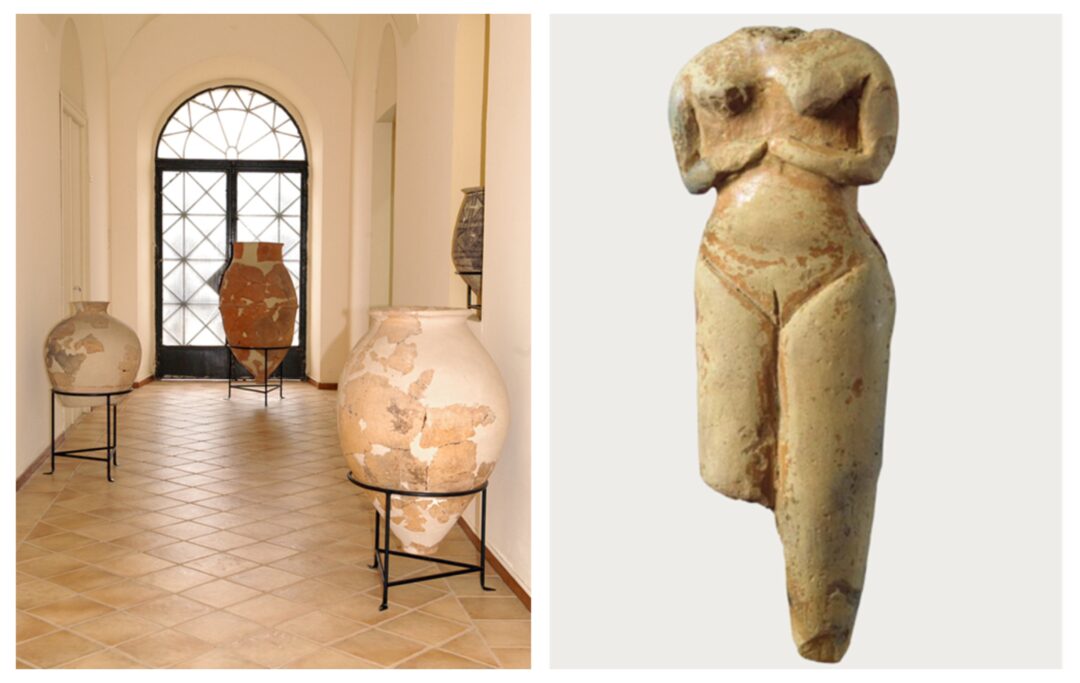
Archaeological Museum of Argos, ceramics from Lerna (left, Source: argolikivivliothiki.gr), A terracotta figurine of a standing nude female dates to the Early Helladic II (Lerna III: 2700-2200 BC) phase (right) (Source: HOCRED)
In the American School of Classical Studies at Athens ASCSA’s latest publication (2024), Lindsay C. Spencer presented the previously unpublished Middle Helladic (MH) pottery from Lerna. The new volume features a catalogue of over 2,400 ceramic objects, accompanied by an analysis of their shapes, decoration, and fabrics, elucidating the changing patterns of ceramic production and consumption at Lerna. MH Lerna has long been regarded as a hub of interaction and exchange. Spencer highlights the significant presence of imported Cretan ceramics from the early MH period, as well as the large number of beautifully decorated drinking vessels and distinctive dark-on-light banded amphoras. She comments on the considerable number of Minoan imports found at Lerna, noting how they were integrated into local dining, serving, and storage sets. She also points out the abundance of large Aiginetan matt-painted barrel jars, used for storage, reflecting on the logistical challenges of transporting these vessels to the site—first by ship and then possibly by donkey. (Source: “A work for the (Middle Bronze) Ages”, American School of Classical Studies at Athens, ASCSA)
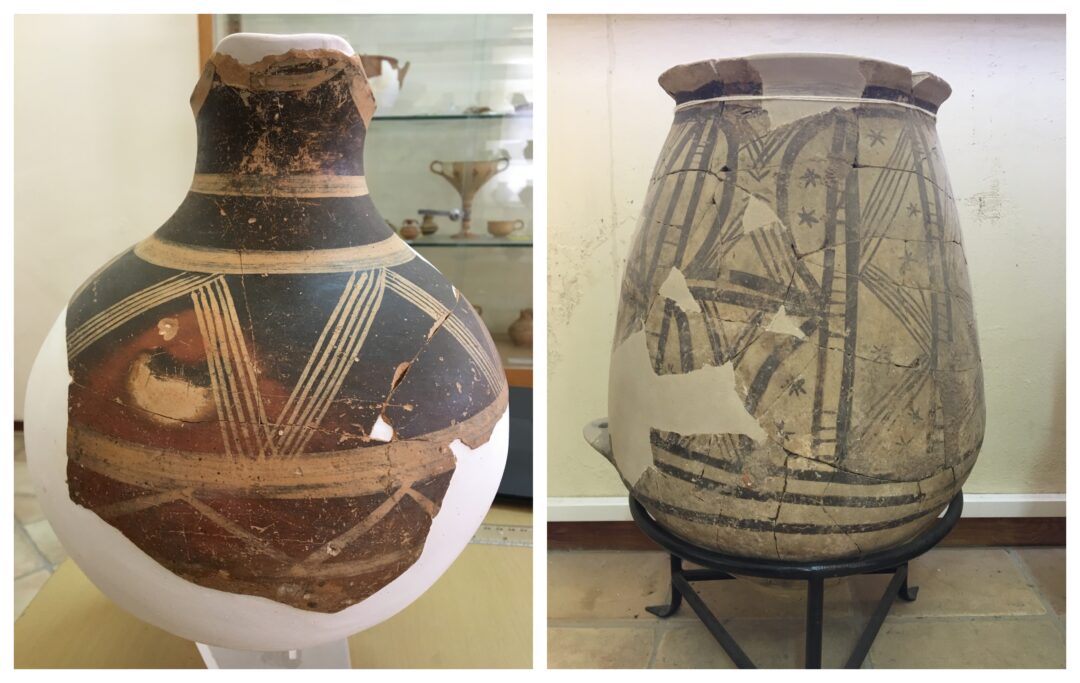
One of the many Minoan vessels found at early MH Lerna (left), A large Aiginetan matt-painted barrel jar from Lerna, over 0.5 m tall (right) (Source: ASCSA)
Lerna is linked to Greek mythology. In spite of the fact that in historical times Lerna was a site of minor importance, it was here that myth placed the bottomless lake of Alkyonia and the spring of Amymone. In Lerna Hercules killed the serpentine monster, the Lernaean Hydra, which had its lair in the springs of Anymone. In this way he secured access to the springs by men, who could make use of the region’s water by transforming its land into farmland.
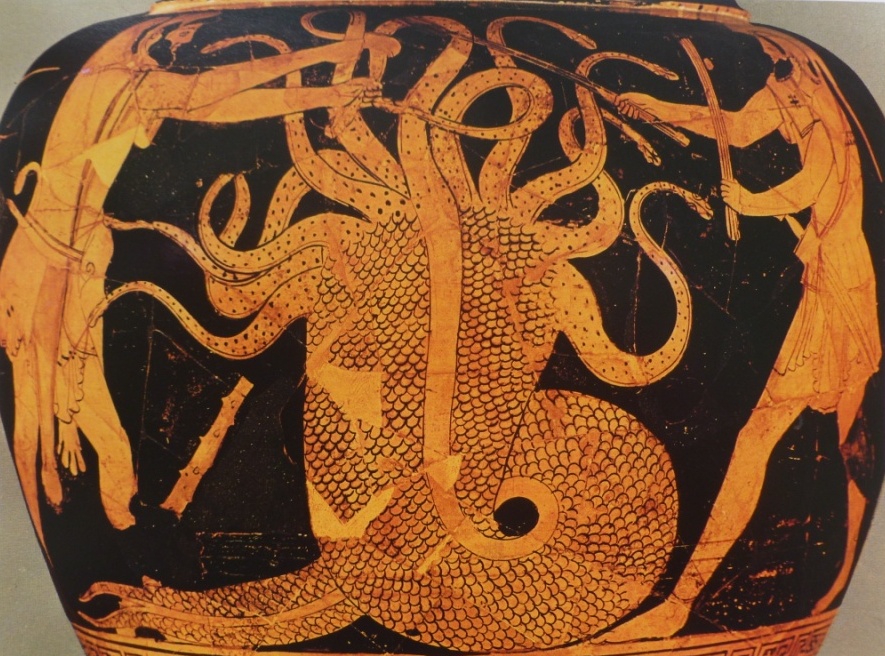
Hercules and Iolaos kill the Hydra of Lerna. Red-figure representation of an Athenian stamnos of the painter of Syleus from the Chiusi of Etruria (480-470 BC), Palermo, Museo Nationale
Danaus and his 50 daughters disembarked south of Lerna and founded the sanctuary of Athena Saitis (on top of Pontinos Hill to the west of the village of Myloi, today occupied by the remains of a Frankish castle). His daughters sank the heads of their slain husbands, the sons of Danaus’ brother Aegyptus, in the waters of the bottomless lake Alkyonia that formed one of the entrances to the Underworld. Hades descended to the Underworld with Persephone from this lake, as did Dionysus, in order to bring his mother Semele back to earth. Dionysus was killed by Perseus, who opposed the new religion, in the waters of Lerna. The Danaid Anymone was united in love with Poseidon and the fruit of their union was Nauplios, the hero-founder of Nauplia.
Modern geological methods identified the location of the sacred Lake Lerna, once a freshwater lagoon separated from the Aegean by barrier dunes. During the Early Bronze Age, the lake was approximately 4.7 km in diameter. However, deforestation accelerated silt accumulation, transforming the lake into a malarial swamp, with the last remnants drained in the 19th century. Today the springs of Lerna and Anymone supply the inhabitants of the municipalities of Nafplio and Argos-Mycenae with drinking water.
(Source: Lerna “Delighting in Water”, Argolisculture.gr, Ephorate of Antiquities of Argolida)
Several monuments in the broader area are worth sightseeing and can be combined with the natural beauty of Argolis, including trekking routes, stunning beaches, and exquisite gastronomy.
Read also: Visit the Argolida Castles
The archaeological sites of Mycenae and Tiryns
Visit Nafplion, One of Europe’s Most Beautiful Towns
I.A.
TAGS: ARCHAEOLOGY | ARGOLIDA | NEOLITHIC | TOURISM

